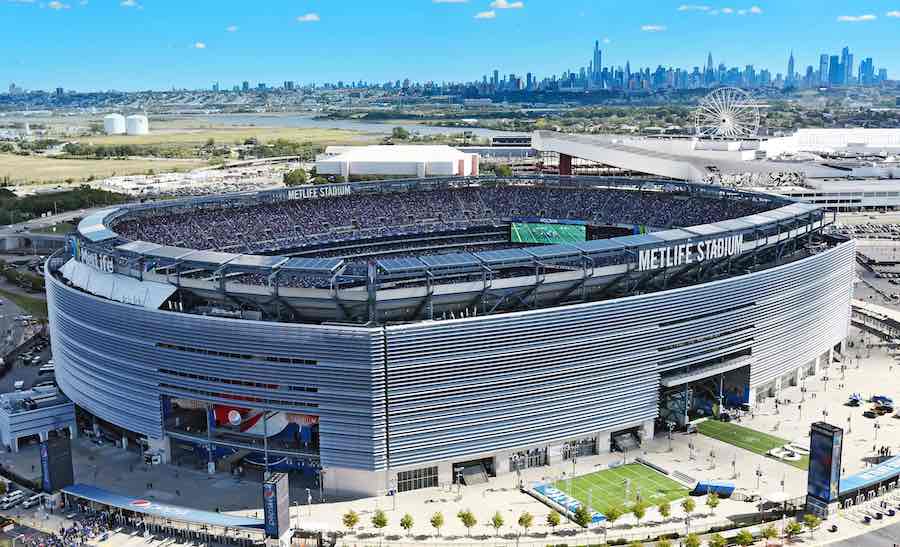The World Cup 2026 soccer championship match will fill Met Life Stadium in New Jersey with 75,000 fans, so a renovation is planned to make the event work—as one of 16 stadiums across North America tapped to host the sport's pinnacle event
In preparation for the tournament, Skanska has already started on a project to renovate the lower bowl of MetLife Stadium, also home venue to both the National Football League New York Jets and New York Giants. The upgrade comes as the stadium needs to reconfigure to fit global soccer federation FIFA field size standards for the eight games scheduled.
To get the work done while the venue stays in heavy use, construction will roll through two phases, with the first scheduled to wrap up in May and the second to run from January 2025 to May 2025.
Sean Szatkowski, Skanska USA Building executive vice present and general manager, says having built the venue for its 2010 opening, “this latest undertaking poses the unique and exciting challenge of making the necessary adjustments needed to meet FIFA requirements.”
Changes coming in New Jersey aren’t the only plans on deck ahead of the 2026 tournament. With 16 venues in 16 cities across the U.S., Mexico and Canada, some stadiums also have announced plans to upgrade, while others are investigating needs with an eye on projects closer to the June 2026 start of the tournament.
HKS Design tells ENR the firm is working with FIFA on potential changes at two of the most prominent U.S. locations, AT&T Stadium near Dallas and SoFi Stadium near Los Angeles, having built both venues and worked with FIFA since the organization began evaluating U.S. venues as possible host sites.
HKS is helping determine what changes may be in store. Previously, AT&T Stadium announced a $350 million upgrade ahead of the World Cup that includes upgrading the world’s largest center-hung HDTV video board, refreshing pro shops, adding concession and bar options and other updates around the site. Specific details haven’t been released.
In Mexico, Populous is working on plans to update Estadio Azteca in Mexico City, the country’s largest venue, ahead of the World Cup. Stadium owners Televisa plan a mix of improvements across the facility but have not yet revealed the final scope of the plans.
BMO Stadium in Toronto will undergo a series of renovations to enable the temporary addition of roughly 17,500 seats. Gensler Architecture & Design Canada Inc., in collaboration with CAA ICON serving as the project manager, will provide all the design and construction administration. The temporary structures and seating will cost about (C)$36 million and the procurement process for the general contractor is in progress.
Seattle’s Lumen Field confirms there will be modifications made to the venue to host World Cup matches, mainly regarding the seating and field configuration, but detailed plans haven’t been set. That’s the same in Santa Clara, California, where a spokesperson for the San Francisco 49ers tells ENR they are looking at potential projects at Levi’s Stadium to ensure “we are well-equipped to host the thousands of fans from around the world.”
The tournament has grouped the 16 stadiums into three regions, making travel easier for the teams and fans. In the Western Region, along with Lumen Field, Levi’s Stadium and SoFi Stadium is BC Place in Vancouver, where the government-owned building has announced it plans to upgrade the site’s hospitality and fan access. Details haven’t been determined.
The Central Region, which includes both Dallas and Mexico City, features Estadio Akron in Guadalajara, Estadio BBVA in Monterrey, Arrowhead Stadium in Kansas City and NRG Stadium in Houston.
The Eastern Region features Hard Rock Stadium in Miami, Mercedes-Benz Stadium in Atlanta, Gillette Stadium in Foxborough, Mass., Lincoln Financial Field in Philadelphia and the venues in New Jersey and Toronto.
As teams continue to monitor the needs for ensuring access for the highest number of spectators possible and that the FIFA-required field size fits within the configurations of the bowl, plans continue to take shape.
FIFA says that eight of the 16 sites need a new shallow profile field surface to go under natural grass, which will be the playing surface at all 16 venues. The federation is working with research teams from the University of Tennessee and Michigan State University to develop the plan for field installation at all venues.
In New Jersey, the project scope offers some of the most intense plans across the three countries, featuring demolition of four corners of exiting precast seating and installation of a new modular steel composite seating system with the related mechanical, electrical, audio visual and plumbing adjustments.
The project will feature removal of 1,740 permanant seats to expand field dimensions, moving those seats to a modular system to maintain current NFL seating quantities and layouts. According to the host committee’s bid book submitted to FIFA, the expected capacity for World Cup games is 75,000.





Post a comment to this article
Report Abusive Comment